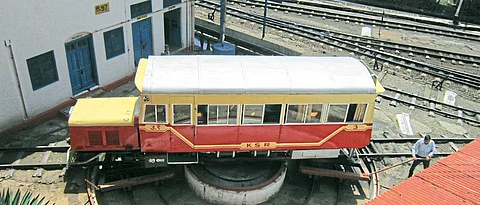

In E M Forster’s A Passage to India, the British are perpetually afraid of the hot weather in India. To escape the heat of the plains, the British made Simla their summer capital. They discovered to their joy that the climate in Simla, 7000 feet above sea level, was identical to the climate of England. And this is fact, not fiction.
A small, narrow gauge train took them then from the plains to the hills. This train, built in 1903, came to be known as the toy train. It exists even today, over a hundred years later, although its passengers are no longer Englishmen but are Indians. In 2008, UNESCO declared the Simla toy train to be a World Heritage Site.
The first toy train built by the British went to Darjeeling, another hill station with a congenial climate. This was in the 1880s. In 1905, Adamji Peerbhoy built the Neral-Matheran toy train. But Matheran in the Sahyadri hills, merely 850 feet above sea level, does not have the salubrious Himalayan climate of Simla and Darjeeling.
There are several legends that surround the Simla toy train. One is that the route for the track was divinely revealed to a local named Bhalku who shared it with the Chief Engineer, H S Harrington. It is said that without the knowledge possessed by Bhalku, the railway would never have been built. Another story concerns Colonel Barog who was assigned the difficult task of digging the route’s 102 tunnels. While digging tunnel number 33, the longest tunnel on the route, he erred. Digging from both ends, he found that his alignment was wrong and the ends would not meet! He was fined one rupee for his mistake. But his mistake so humiliated him that he committed suicide. Today, tunnel number 33 is named Barog Tunnel and the station just outside the tunnel is called Barog station. The Barog Tunnel is nicknamed ‘Kissing Tunnel’ because it is long enough for people to kiss while the train passes through it.
The toy train takes nearly six hours to cover its 68 mile journey from Kalka in Haryana to Simla in Himachal Pradesh. This makes it boring to some who prefer to travel to Simla by taxi or bus that takes half the time to reach. But to passengers who value heritage, a ride on the train is a must. The train journey is any day more scenic than the journey by road. The chugging of the wheels and the whistle of the engine add to the romance.
In 1903, there was only one train that took passengers to Simla. Today, there are at least four. Ticket prices range from Rs 25 for an unreserved second class journey to Rs 420 for a ride on the Shivalik Express which covers the distance in just four-and-a-half hours, and on which breakfast is served free of cost. Some trains have an old colonial style First Class cabin which offers much privacy. A unique Rail Motor Car with a minimum capacity of 10 passengers also runs on the route.
The toy train to Darjeeling is hauled by a steam engine. The Simla toy train, however, is pulled by a diesel engine. But the turn table at Simla station, which once turned steam engines around, still exists and is used by the bus-shaped Rail Motor Car.
The four most important stations on the Kalka-Simla route are Barog, Solan, Tara Devi and Summer Hill. Author Salman Rushdie has a house in Solan that he inherited from his grandfather.
Snow gathers on the rail tracks at Simla during winter, but the trains continue to run. Unlike the Neral-Matheran train that does not run in the monsoon, the Simla toy train runs throughout the year.
I would advise Puneites who wish to travel on the Simla toy train this summer to go all the way to Kalka by rail, and not by air. There is a Shatabdi Express that leaves New Delhi at 7.45 am everyday and reaches Kalka at 11.45 am. Half an hour later, there is a toy train from Kalka that arrives in Simla at 5.30 pm.
There are three trains from Pune that reach Hazrat Nizamuddin station (New Delhi) in time to board the morning Kalka Shatabdi — a weekly AC Express that leaves at 5.35 am on Sunday, a Duronto Express that leaves at 11.10 am on Tuesday and Friday; and the Goa Express that leaves at 4.40 am every day. The first two trains have only air conditioned accommodation, but the Goa Express has sleeper accommodation as well.
Unfortunately, there is no train from Pune that provides a suitable connection to the prestigious Shivalik Express that leaves Kalka at 5.20 am. If one wants to travel on the Shivalik Express, one has to be willing to wait it out at New Delhi and Kalka. Both stations have retiring rooms. Incidentally, there is an evening Shatabdi Express that leaves New Delhi at 5.15 pm and reaches Kalka at 9.20 pm.
A ride on the Simla toy train has the potential to wean us away from our smartphones to enjoy nature in all its splendour. Our geography has grown so poor that there are youngsters in this part of India today who haven’t even heard of Simla and Darjeeling! And even if they have, they don’t know how to get there. It is time to change all that.
